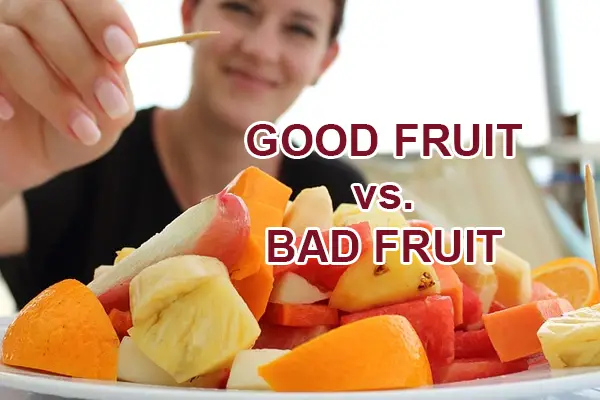
We are a long way away from the past misconception that any sugar is bad sugar when it comes to diabetes. While there are even groups of people who cure their diabetes by eating enormous quantities of fruits – such as RAW foodies and fruitarians – science has now found solid evidence that is easily adaptable into any diet. And if you love fruits – science has really good news for you.
Most fruits do not cause, but actually prevent type-2 diabetes.
There is, however, an exception. While fruit itself is associated with a lower risk for type-2 diabetes, fruit juice is associated with a higher risk of this disease. The main reason for this is that whole fruit contains fiber, while juice does not. And fiber stabilizes blood sugar levels.
These findings were brought to us by a 2013 study by Harvard scientists. They took information from a total of 187,382 participants from the Nurses’ Health Study collected in 1984-2009. They studied their fruit eating habits, while taking into consideration other diabetes risk factors and lifestyle differences. They also reviewed 56 total studies, and eventually concluded that:
“Greater consumption of specific whole fruits…is significantly associated with a lower risk of type 2 diabetes, whereas greater consumption of fruit juice is associated with a higher risk.”

The Harvard study found eight fruits to be beneficial for diabetes prevention, one fruit to put people at a higher risk for type 2 diabetes, and strawberries had no effect.
Here are 5 fruits that the Harvard researchers found to be especially good for prevention of diabetes:
Blueberries: Blueberries were shown as the absolute number one fruit for diabetes prevention – the other fruits did not even come close in comparison. If you drink juice, replacing it with three servings of blueberries per week cuts type 2 diabetes risk by a whole 33%.
Red grapes: Type 2 diabetes prevents the body’s normal production of the hormone insulin, which gathers glucose from the blood and stores it in the cells for slowly released energy. Instead, a lack of insulin causes the sugar spikes in the blood. Red grapes, along with blueberries and apples, contain high levels of anthocyanins, which increase glucose uptake. They are also known to protect against many diseases.
Apples: Apples just like prunes, peaches, plums, and apricots, contain chromogenic acid, which helps prevents diabetes. This natural substance is also why many studies say that coffee, specifically, green coffee beans can help cut diabetes risk as well.
Prunes: Prunes have a preventative effect because of chromogenic acid, as described above. They are also high in soluble fiber, which makes the absorption of sugar slower – preventing sugar spikes.
Bananas: Bananas were also found to prevent diabetes. They are high in fiber, which reduces spikes in blood sugar. Especially safe as the green or unripe bananas. Bananas are a fascinating fruit because it contains different nutrients based on its ripeness. Ripe and unripe bananas differ greatly. Unripe bananas contain resistant starch – “resistant” to digestion, meaning the body absorbs it the same way as fiber making it beneficial for stabilizing sugar levels. A different study has shown that women with type 2 diabetes had better sugar levels when consuming resistant starch.
Grapefruit: Grapefruit is also high in fiber, which stabilizes blood sugar levels. It helps lower insulin levels, which reduces the risk of developing diabetes. In a study by Berkeley University, it was found that naringin, a compound found in grapefruit, lowers blood glucose levels as well as a popular but side-effect ridden glucose-lowering drug called metformin.

Out of all the fruit studied, Harvard scientists only found cantaloup to increase the risk of developing diabetes. PHOTO: publicdomainpictures.net
And this is the one fruit that was found to increase the risk for diabetes:
Cantaloupe: Cantaloupe was the only fruit that Harvard scientists studied that showed an increased risk for diabetes. There is nothing inherently bad about melons, however, they did rate high on the high glycemic index. There is no reason to panic, however. Other studies gave cantaloupe a thumbs-up because it is a low-carb fruit.
Final Word: Whole Fruit Is An Excellent Addition to Your Diet
The Harvard Study was not the only study to show that fruit consumption is associated with lower diabetes risk. A study from China suggested that eating fresh fruit daily cuts the risk by 12%, because fruit releases sugars slowly into the bloodstream that does not cause sugar spikes. This study highlighted apples, pears, and oranges, as safe fruit to eat – they also happen to be few of Chinese people’s favorites, according to the study.
There are many other studies out there, and while some do not exactly on some fruits such as cantaloupe, the five found by the Harvard study found are the safest, so be sure to eat plenty of them (organic whenever possible).
This article is for informational purposes only and is not intended to prevent, treat or diagnose any disease. Speak with a doctor before making any major changes to your diet. See our full disclaimer here.
***
Why is diabetes completely misunderstood and mismanaged by conventional medicine? It doesn’t have to be… Don’t miss The Diabetes Summit 2018 from April 23-30, free and online!
Recommended reading:
A Cup of Blueberries a Day Protects Against Two of the Most Degenerative Diseases Known to Man
This Little Known Grape Has 40X More Cancer Killing Resveratrol Than Red Wine
Thanks for installing the Bottom of every post plugin by Corey Salzano. Contact me if you need custom WordPress plugins or website design.





